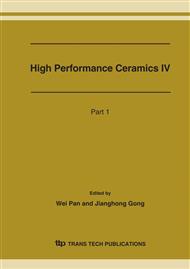p.1673
p.1676
p.1679
p.1683
p.1688
p.1692
p.1696
p.1699
p.1703
Preparation of Biphasic Calcium Phosphate Porous Ceramics Prepared from Fine Powders with Different Particle Size and its Dissolution Behavior in Simulated Body Fluid
Abstract:
Biphasic calcium phosphate (BCP) ceramics, a mixture of hydroxyapatite (HAp) and betatricalcium phosphate (β-TCP), of varying HAp/β-TCP ratios was prepared. One kinds of HAp and one kind of β-TCP powders were used to produce porous BCP bioceramics with HAp/β-TCP weight rations of 20/80, 40/60, and 80/20. A slip was obtained by adding a mixed powders of HAp and β-TCP to a solution 1.5% of deflocculant and 0.5 wt% of foaming agent. The optimum value for the minimum viscosity in these present slips with respect to its solid loading and the optimum amount of the deflocculant were investigated. The specimen obtained by casting a polyurethane foam with 1.5 wt% of deflocculant into a slip, and drying it under vacuum, was heated at 1150°C for 3 hours. The resultant porous BCP sintered body had large spherical pores of 300 /m with interconnecting rectangular voids. Many small pores in the size range of 2-3 /m or below were observed in the specimen obtained by heating at 1150°C for 3 hours. The dissolution test was done as follows. The obtained porous ceramics samples about 0.5g individually soaked into 30 mL of simulated body fluid (SBF) solution at 36.5°C. The calcium and phosphorous content of the SBF solution was analyzed by ICP. The porous body was dried, and characterized using SEM, XRD, and FT-IR.
Info:
Periodical:
Pages:
1688-1691
Citation:
Online since:
April 2007
Authors:
Price:
Сopyright:
© 2007 Trans Tech Publications Ltd. All Rights Reserved
Share:
Citation:


